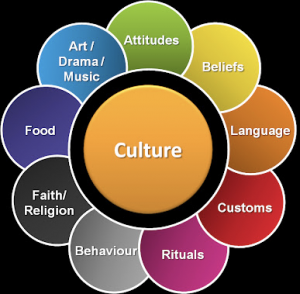Cultural Value
Cultural value differs from one individual to another; however, generally, it is described as the collective value we place on culture in our community and in our society. Edward T Hall’s Cultural Iceberg Theory uses the analogy of an iceberg to help explain the concept of cultural value.
Video 3.1: Iceberg model of culture.
As you watch this video, think about the different factors that contribute to the culture in your own community (See Figure 3:3 Factors contributing to culture). What factors do you think are above the water, and what factors are below?

Tangible vs. intangible culture
In our community, we can find both tangible cultural assets and intangible cultural assets. Tangible cultural assets are the things that may sit at the tip of the iceberg and are more visible. In very simple terms these are the things you can see, hear, taste, smell, and touch such as music, dance, theatre, art, public art, galleries, historical buildings, monuments. Using the iceberg model, the things that are below the water and harder to see are what we would consider as intangible culture. This includes things that are experienced rather than seen or touched such as stories, and traditions, and values.
UNESCO has developed a series of instruments to identify, preserve, measure and communicate the value and importance of cultural heritage throughout the world. Cultural heritage includes both tangible and intangible assets such as monuments, traditions and living expressions. UNESCO identifies: “Oral traditions, performing arts, social practices, rituals, festive events, knowledge and practices concerning nature and the universe or the knowledge and skills to produce traditional crafts” (UNESCO, n.d.e, para. 1).
UNESCO promotes the social and economic value of culture and contemporary and traditional living, highlighting that culture is not just in the past but also in how we live in the present day. It is inclusive, representative and also community-based (UNESCO, n.d.e). More and more communities are recognising the value of this interconnectivity between tangible and intangible culture and social economic and environmental elements in our communities.
